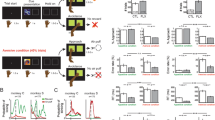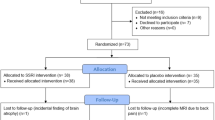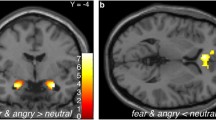Abstract
Background
Acute administration of selective serotonin and noradrenaline re-uptake blockers to healthy volunteers affects the processing of emotional information but it is not known if similar effects occur with antidepressants acting through other pharmacological mechanisms. Mirtazapine is a clinically established antidepressant with complex actions involving blockade of noradrenaline α2-adrenoceptors as well as a number of 5-HT receptor subtypes. The aim of the present study was to test whether, like monoamine re-uptake inhibitors, mirtazapine would also produce positive biases in emotional processing.
Methods
We studied 30 healthy volunteers who received either a single dose of mirtazapine (15 mg) or placebo in a parallel group, double-blind study. Two hours following medication administration, participants completed a battery of tasks testing various aspects of emotional processing including facial expression recognition, emotion potentiated startle, and emotional categorization and memory.
Results
Compared to placebo, mirtazapine significantly impaired the recognition of fearful facial expressions and reduced eye-blink responses in the emotion potentiated startle task. Participants receiving mirtazapine were also significantly quicker to respond to emotional self-relevant information in the categorization task and showed a positive bias in memory recall compared to those receiving placebo.
Conclusions
Our findings indicate that mirtazapine reduces fear processing in healthy volunteers, an effect similar to that produced by repeated administration of selective serotonin re-uptake inhibitors. In addition, mirtazapine increased memory for likeable versus dislikeable self-relevant information suggesting an induction of positive bias in emotional memory. Such effects may be important for our understanding of the neuropsychological mechanisms of antidepressant action in both anxiety and depressive disorders.


Similar content being viewed by others
References
Anderson NH (1968) Likableness ratings of 555 personality trait words. J Pers Soc Psychol 9:272–279
Baas JM, Grillon C, Bocker KB, Brack AA, Morgan CA III, Kenemans JL, Verbaten MN (2002) Benzodiazepines have no effect on fear-potentiated startle in humans. Psychopharmacology (Berl) 161:233–247
Blair RJ, Curran HV (1999) Selective impairment in the recognition of anger induced by diazepam. Psychopharmacology (Berl) 147:335–338
Bourin M, Dhonnchadha BA (2005) 5-HT2 receptors and anxiety. Drug Dev Res 65:133–140
Browning M, Reid C, Cowen PJ, Goodwin GM, Harmer CJ (2007) A single dose of citalopram increases fear recognition in healthy subjects. J Psychopharmacol 21(7):684–690
Burghardt NS, Sullivan GM, McEwen BS, Gorman JM, LeDoux JE (2004) The selective serotonin reuptake inhibitor citalopram increases fear after acute treatment but reduces fear with chronic treatment: a comparison with tianeptine. Biol Psychiatry 55:1171–1178
Davis R, Wilde MI (1996) Mirtazapine: a review of its pharmacology and therapeutic potential in the management of major depression. CNS Drugs 5:389–402
Deakin JFW, Graeff FG (1991) 5-HT and mechanisms of defence. J Psychopharmacology 5(4):305–315
Ekman PFW, Friesen WV (1976) Pictures of facial affect. Consulting Psychologists, Palo Alto
Grillon C (2002) Startle reactivity and anxiety disorders: aversive conditioning, context, and neurobiology. Biol.Psychiatry 52:958–975
Grillon C, Levenson J, Pine DS (2005) A single dose of the selective serotonin reuptake inhibitor citalopram exacerbates anxiety in humans: a fear potentiated startle study. Neuropsychopharmacology 32:225–331
Harmer CJ (2008) Serotonin and emotional processing: does it help explain antidepressant drug action? Neuropharmacology 55:1023–8
Harmer CJ, Bhagwagar Z, Perrett DI, Vollm BA, Cowen PJ, Goodwin GM (2003a) Acute SSRI administration affects the processing of social cues in healthy volunteers. Neuropsychopharmacology 28(1):148–52
Harmer CJ, Hill SA, Taylor MJ, Cowen PJ, Goodwin GM (2003b) Toward a neuropsychological theory of antidepressant drug action: increase in positive emotional bias after potentiation of norepinephrine activity. Am J Psychiatry 160(5):990–2
Harmer CJ, Shelley NC, Cowen PJ, Goodwin GM (2004) Increased positive versus negative affective perception and memory in healthy volunteers following selective serotonin and norepinephrine reuptake inhibition. Am J Psychiatry 161(7):1256–63
Harmer CJ, Reid CB, Ray MK, Goodwin GM, Cowen PJ (2006) 5HT(3) antagonism abolishes the emotion potentiated startle effect in humans. Psychopharmacology 186(1):18–24
Harmer CJ, Heinzen J, O'Sullivan U, Ayres RA, Cowen PJ (2008) Dissociable effects of acute antidepressant drug administration on subjective and emotional processing measures in healthy volunteers. Psychopharmacology (Berl). 199:495–502
Howell D (2002) Statistical Methods for Psychology. Belmont, CA
Lader MH, Scotto JC (1998) A multicentre double-blind comparison of hydroxyzine, buspirone and placebo in patients with generalized anxiety disorder. Psychopharmacology 139:402–406
Lang PJ, Bradley MM, Cuthbert BN (1998) International affective picture system (IAPS): Technical Manual and Affective Ratings.Gainesville, FL. The Center for Research in Psychophysiology. University of Florida
Murphy SE, Downham C, Cowen PJ, Harmer CJ (2008) Direct effects of diazepam on emotional processing in healthy volunteers. Psychopharmacology (Berl). 199:503–13
Nutt DJ (2002) The neuropharmacology of serotonin and noradrenaline in depression. Int Clin Psychopharmacol 17(Suppl 1):S1–12
Olivier B, Van Wijngaarden I, Soudijn W (2000) 5-HT3 receptor antagonists and anxiety; a preclinical and clinical review. Eur Neuropsychopharmacol 10:77–95
Spitzer RLWJ, Gibbon M (2002) Structured Clinical Interview for the DSM-IV. New York Psychiatric Institute, New York
Whale R, Clifford EM, Cowen PJ (2000) Does mirtazapine enhance serotonergic neurotransmission in depressed patients? Psychopharmacology 148:325–326
Young AW, Rowland D, Calder AJ, Etcoff NL (1997) Facial expression megamix: tests of dimensional and category accounts of emotion recognition. Cognition 63(3):271–313
Zangara A, Blair RJ, Curran HV (2002) A comparison of the effects of a beta-adrenergic blocker and a benzodiazepine upon the recognition of human facial expressions. Psychopharmacology (Berl) 163:36–41
Disclosure/conflict of interest
This study was funded by the UK MRC. DA is currently supported by the UK MRC. PJC has received remuneration from serving as a member of advisory boards of Eli Lilly, Wyeth, Servier, Xytis and DSM. CJH serves on the advisory panel of P1vital and has received remuneration for consultancy from the following companies: Lundbeck, Servier and P1vital.
Author information
Authors and Affiliations
Corresponding author
Rights and permissions
About this article
Cite this article
Arnone, D., Horder, J., Cowen, P.J. et al. Early effects of mirtazapine on emotional processing. Psychopharmacology 203, 685–691 (2009). https://doi.org/10.1007/s00213-008-1410-6
Received:
Accepted:
Published:
Issue Date:
DOI: https://doi.org/10.1007/s00213-008-1410-6




